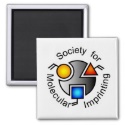|
|
Reference type: Journal
Authors: Chang PP, Zhang ZJ, Yang CY
Article Title: Molecularly imprinted polymer-based chemiluminescence array sensor for the detection of proline.
Publication date: 2010
Journal: Analytica Chimica Acta
Volume: 666
Issue: (1-2)
Page numbers: 70-75.
DOI: 10.1016/j.aca.2010.03.031
Alternative URL: http://www.sciencedirect.com/science/article/B6TF4-4YNT497-3/2/38a9c87e745f158b22018c9be11b702d
Abstract: A new molecularly imprinted polymer (MIP)-chemiluminescence (CL) method has been developed for detection of proline. The molecularly imprinted polymer microspheres were synthesized using precipitation polymerization with hydroxyproline, a structural analogue, as the template. Polymer microspheres were immobilized in microtiter plates (96 wells) which selectively adsorbed the analyte (dansyl-proline). After washing, the bound fraction was quantified based on peroxyoxalate chemiluminescence (PO-CL) reaction enhanced by imidazole. The cavity of MIP synthesized with hydroxyproline as template is smaller, which can avoid non-specific adsorption and lead to enhancement of specificity, response speed and sensitivity when recognizing dansyl-proline. Under the optimum conditions, the relative CL intensity has a linear relationship with the concentration of proline in the range of 1 x 10-6 mol L-1 to 4 x 10-5 mol L-1, with a limit of detection 3 x 10-7 mol L-1 (3σ). The relative standard deviation (R.S.D.) for proline (1x 10-6 mol L-1, n = 7) was 3.7%. The MIP-CL method can become a useful analytical technology for determination of proline in real sample
Template and target information: proline, dansyl-proline
Author keywords: molecularly imprinted polymer, chemiluminescence, array sensor, Proline, precipitation polymerization
|


 MI cryptic logo iphone3 speckcase
MI cryptic logo iphone3 speckcase







 SMI magnet white
SMI magnet white







 SMI logo hat
SMI logo hat






